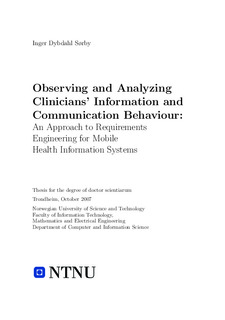| dc.contributor.author | Sørby, Inger Dybdahl | nb_NO |
| dc.date.accessioned | 2014-12-19T13:30:11Z | |
| dc.date.available | 2014-12-19T13:30:11Z | |
| dc.date.created | 2008-04-17 | nb_NO |
| dc.date.issued | 2007 | nb_NO |
| dc.identifier | 124128 | nb_NO |
| dc.identifier.isbn | 978-82-471-4851-8 | nb_NO |
| dc.identifier.uri | http://hdl.handle.net/11250/249892 | |
| dc.description.abstract | Advanced information systems have great potential for supporting clinicians in their patient-centered work. In order to meet the specific information and communication needs of healthcare professionals during a wide range of situations, there is an increased focus on developing context-aware user interfaces for pervasive health information systems. However, the high information and communication intensity, the nature of clinical work, and the complexity of healthcare organizations make the system design process, and especially the requirements engineering (RE) phase, particularly challenging.
This thesis addresses how structured observation can be used as a technique for elicitation and analysis of requirements for mobile electronic patient record (EPR) systems. The thesis explores how important properties of clinical situations can be captured through observation of actors, processes, and systems.
The contributions of the thesis consist of two main components:
• An iteratively developed method for structured, focused observation and analysis of clinicians’ information and communication behaviour
• Exploration of how the observational data can be analyzed with varying foci and perspectives, and how the results of the processed data may be used as input to the requirements engineering process
The approach has been developed and refined during several observational studies performed in different hospital wards. The development process and the observational studies are presented in the eight papers which constitute the main part of this thesis.
Medical students are found to be particularly suited for performing the observations due to their domain knowledge and natural presence as apprentices in hospital wards. As future users of the information systems they can also function as mediators between the end users and the system developers, both during the data collection and the analysis phases of the studies.
The recorded observational data consists of sequences of events or communicative acts. When analyzing the data, it is possible to produce patient, process, or actor trajectories. In the thesis it is suggested how this can be used to inform implementation of clinical guidelines. Examples of how communicative patterns of actors and roles can be visualized and directions for how this can be used in the RE process are also given. | nb_NO |
| dc.language | eng | nb_NO |
| dc.publisher | Norges teknisk-naturvitenskapelige universitet, Fakultet for informasjonsteknologi, matematikk og elektroteknikk, Institutt for datateknikk og informasjonsvitenskap | nb_NO |
| dc.relation.ispartofseries | Doktoravhandlinger ved NTNU, 1503-8181; 2007:220 | nb_NO |
| dc.relation.haspart | Sørby, Inger Dybdahl; Melby, Line; Nytrø, Øystein. Characterising cooperation in the ward: framework for producing requirements to mobile electronic healthcare records. Int. J. of Healthcare Technology and Management. 7(6): 506-521, 2006. | nb_NO |
| dc.relation.haspart | Dahl, Yngve; Sørby, Inger Dybdahl; Nytrø, Øystein. Context in Care – Requirements for Mobile Context-Aware Patient Charts. Medinfo 2004. Proceedings of the 11th world congress on health (medical) informasion - Studies in health Technology and Informatics, 2004. | nb_NO |
| dc.relation.haspart | Sørby, Inger Dybdahl; Nytrø, Øystein. Does the EPR support the discharge process? A study on physicians’ use of clinical information systems during discharge of patients with coronary heart disease. Health Information Management Journal. 34(4): 112-119, 2005. | nb_NO |
| dc.relation.haspart | Sørby, Inger Dybdahl; Nytrø, Øystein; Røst, Thomas. Empirical Grounding of Guideline Implementation in Cooperative Clinical Care Situations. Al techniques in healthcare: evidence.based guidelines and protocols - Proceedings of workshop at ECAI 2006: 111-120, 2007. | nb_NO |
| dc.relation.haspart | Sørby, Inger Dybdahl; Nytrø, Øystein. A Study of Clinicians’ Information Systems Usage in Patient-Centered Situations - Preliminary Results. . | nb_NO |
| dc.relation.haspart | Sørby, Inger Dybdahl; Nytrø, Øystein. Towards a Tomographic Framework for Structured Observation of Communicative Behaviour in Hospital Wards. REFSQ 2007 - Proceedings of the international working conference on Requirements Engineering: Foundations for Software Quality: 262-276, 2007. | nb_NO |
| dc.relation.haspart | Sørby, Inger Dybdahl; Nytrø, Øystein. Analysis of Communicative Behaviour: Profiling Roles and Activities. IT in Health Care - Proceedings of the 3rd International Conference on Information Technology in Health Care: 111-120, 2007. | nb_NO |
| dc.title | Observing and Analyzing Clinicians’ Information and Communication Behaviour: An Approach to Requirements Engineering for Mobile Health Information Systems | nb_NO |
| dc.type | Doctoral thesis | nb_NO |
| dc.contributor.department | Norges teknisk-naturvitenskapelige universitet, Fakultet for informasjonsteknologi, matematikk og elektroteknikk, Institutt for datateknikk og informasjonsvitenskap | nb_NO |
| dc.description.degree | dr.scient. | nb_NO |
| dc.description.degree | dr.scient. | en_GB |
